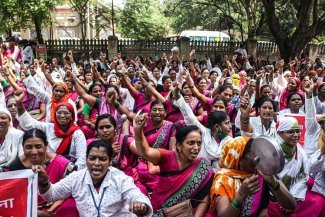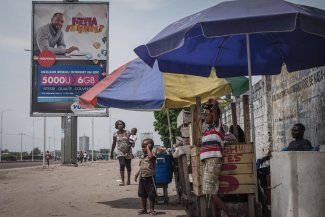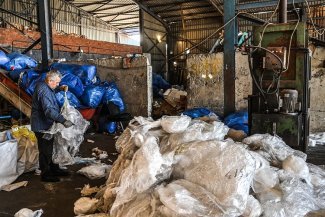
Chand Bibi, 38, runs a one-room informal school for girls in a slum on the outskirts of Pakistan’s capital city, Islamabad.
The overwhelming majority of people living in the area are of Pakhtun origin, and come from the areas of Afghanistan and Pakistan worst affected by the Taliban insurgency.
Hailing from a conservative Pakhtun family in Mingora, the same town in Swat province where 15-year-old school girl activist Malala Yousafzai was shot by the Taliban in October 2012, Chand was denied an education.
“I still remember my brothers setting out for school every day but I, being a girl, was not allowed to go to school,” she told Equal Times.
“It took me 25 years to get the courage to start attending a non-traditional school in Mingora, but my father never knew that I was going to school.”
Chand finally matriculated at the age of 35 and started teaching her cousins and nieces.
In 2009, she left her hometown and moved to Islamabad after military operation against Taliban forced her to leave Swat.
Since then, Chand has been trying her level best to ensure that poor girls living in the slums would not be denied an education.
“I have few resources and can only teach 25 girls at a time. It is nothing in a slum where thousands of families live.
“There is no public school in the locality. I have been facing tough resistance from male counterparts but I am not ready to bow to the pressure. Some of them even threatened me, but if I left, these girls would lose hope.”
She said that in becoming a global symbol for the right of girls to have an education, Malala is an important role model for Pakistani girls, especially those hailing from Pakhtun families.
“More families are sending their girls to schools now. I can even see a day when a Pakhtun girl being educated will be an honour, not a shame,” she said.
Gender gap
In Pakistan, a country where nearly three-quarters of young girls are not enrolled in primary school, the interventions of people like Chand are a blessing.
Although last week’s Learning for All Ministerial roundtable – held as part of the IMF/World Bank spring meetings in Washtington DC – highlighted some of the progress being made towards the Millennium Development Goals on Education, there is still a long way to go.
Globally, 32 million girls are still out of school.
And in Pakistan, according to Unesco’s 10th Education for All Global Monitoring Report (released in October 2012), not enough is being done to reduce the gender gap in education.
The report states that 78 per cent of Pakistan’s poorest were not in school in 1991, a figure which has only reduced to just 62 per cent in 2012.
In Pakistan there are five million children who are not enrolled in school and three million of them are girls.
Dilsahd Begum, district education officer in the Swat district, said that less than 30 per cent of girls in the district are enrolled in primary school.
However, culture isn’t the only factor.
“Militancy also plays an important role to keep girls out of schools in Swat and other parts of the troubled Khyber Pakhtunkhwa province,” she said.
“In Swat, the Taliban has destroyed 124 girls school and 93 others were damaged.”
However, she said that things are slowly changing in the area.
“From 74,904 female students in Swat in 2009, the number increased to around 118,594 students in 2011.”
Structural obstacles
On 5 April Malala teamed up with American actress Angelina Jolie to launch a charity to fund girls’ education. They announced that the first project of the “Malala Fund” would be the construction of a school for 40 girls in her home town of Mingora.
“Let us turn the education of 40 girls into 40 million girls,” Malala said in a recorded message.
In other areas of country, the problems are different.
In the provinces of Punjab and Sindh, a lack of infrastructure and basic facilities at girls’ schools are two of the main factors preventing their education.
An education official in the Rawalpindi district of Punjab province (who spoke to Equal Times on the condition of anonymity) said that there were a total of 619 girls’ schools in the district.
“Basic facilities like toilets are not available in 488 girls’ schools, 300 have no clean drinking water while 165 schools have no boundaries,” he said.
Abid Somro, a senior official at the Ministry of Education in Sindh province, said that out of 49,000 public schools in Sindh only 11 per cent are girls’ schools.
“More than 75 per cent of them are closed down. Lack of infrastructure and basic facilities are major issues but the prime issue is that teachers are not ready to go to school.
“Most of them belong to influential families and they just come to schools to draw their salaries,” he said, remarking that the dropout rate of girls is 60 per cent in Sindh.
“Most of the education budget goes to pay the salaries of the teachers,” he added.
Zehra Arshad, national coordinator at the Pakistan Coalition for Education — an alliance of around 200 NGOs and other stakeholders working on education — said that recent governments had been working hard to bring more girls to school.
“The attack on Malala helped our rulers to realise the importance of girls’ education. The international community has also started focusing more on girls’ education in Pakistan after the incident. A special fund has been established by the UN under Malala’s name to promote girls’education.
"Earlier, the government of Pakistan has also included the right to education as part of the constitution which is good step as well. But, we need to do a lot.”
When asked about Pakistan’s chances of meeting its MDG on education, Arshad was realistic. “We will miss the Millennium Development Goal on education by a big margin.”
And yet, there is light at the end of tunnel.
Tahira Khan, 12, a grade five student at The Nation School in Karachi was among the four students who were injured earlier this year on 30 March, when gunmen attacked the school during an award-giving presentation.
The school principal, Abdul Rasheed Khan, was killed along with a female student. But Tahira continues to go to school. “I am not afraid of the attackers. I will continue studying.”
Tahira still remembers the day when Malala visited her school only a couple of months before Malala herself was shot. “She is my inspiration. I want to become like her.”
- On 28 April, Education International, the global federation of teachers’ unions, will be launching a Teachers’ Scholarship Fund in Karachi to commemorate all of the teachers and students who have been killed or injured in the name of educating girls in Pakistan. To contribute to the fund or to find out more information, click here
- You can also sign the Education Envoy petition to the Pakistani government to end the killings and violence that prevent girls’ education and to ensure that all girls can go to school








